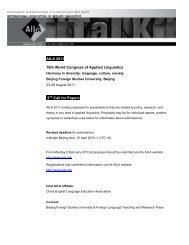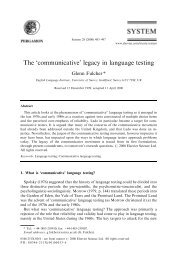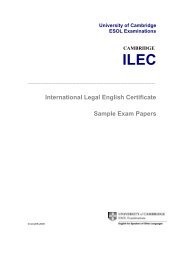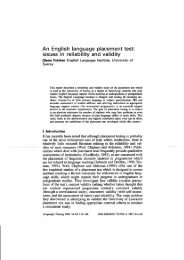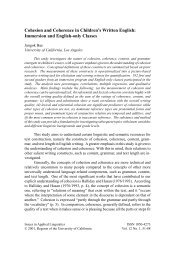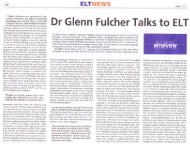Liaison Magazine - LLAS Centre for Languages, Linguistics and ...
Liaison Magazine - LLAS Centre for Languages, Linguistics and ...
Liaison Magazine - LLAS Centre for Languages, Linguistics and ...
You also want an ePaper? Increase the reach of your titles
YUMPU automatically turns print PDFs into web optimized ePapers that Google loves.
teaching<br />
Cigdem Balim estimates the<br />
proportion of students with some<br />
background in Arabic be<strong>for</strong>e coming<br />
to university to be around 10%.These<br />
students are given a proficiency test,<br />
<strong>and</strong> if they have a basic level of<br />
proficiency but are not advanced<br />
enough to enter a second or thirdyear<br />
course, they may be able to enrol<br />
in an intensive first-year course that<br />
covers two semesters of Arabic in one<br />
semester.This type of specialised<br />
course is not very widespread, <strong>and</strong><br />
most universities integrate students<br />
with some prior background into the<br />
most appropriate level along with<br />
students who are (or who started as)<br />
true beginners.<br />
The challenges facing Arabic<br />
programmes across the United States<br />
– from increased student numbers to<br />
classes that include students with a<br />
variety of language levels – mean that<br />
many programmes are stretched to<br />
their limits. One pressing issue in<br />
recent years has been the current lack<br />
of qualified instructors to meet the<br />
increased dem<strong>and</strong> (Howard 2007).<br />
Government spending on<br />
programmes to improve proficiency in<br />
“critical” languages, including Arabic,<br />
has increased but is still considered<br />
modest by professionals in the field<br />
(Bollag 2007). Some have reacted with<br />
suspicion to government funding of<br />
Arabic programmes <strong>and</strong> the clear<br />
defense-related agenda influencing this<br />
(Geisler 2006). Student numbers<br />
indicate an interest in the Arab world<br />
that is encouraging, whatever the<br />
reason behind it, but support from<br />
both government <strong>and</strong> universities will<br />
be necessary to truly take advantage<br />
of current dem<strong>and</strong> <strong>and</strong> produce<br />
students who are proficient in Arabic<br />
<strong>and</strong> more educated about this part of<br />
the world.<br />
Dr Lisa Bernasek is a Senior<br />
Research Assistant at the Subject<br />
<strong>Centre</strong> <strong>for</strong> <strong>Languages</strong>, <strong>Linguistics</strong> <strong>and</strong><br />
Area Studies. She completed her<br />
PhD in Social Anthropology <strong>and</strong><br />
Middle Eastern Studies at Harvard<br />
University in September 2007, <strong>and</strong><br />
has taught first-year Arabic at<br />
Harvard <strong>and</strong> at the University of<br />
Southampton.<br />
Bibliography<br />
Bollag, B. (2007) A failure to communicate. The Chronicle of<br />
Higher Education. 53 (34), 24.<br />
Brustad, K., Al-Batal, M. <strong>and</strong> Al-Tonsi, A. (2004) Al-Kitaab fii<br />
Ta c allum al- c Arabiyya:A Textbook <strong>for</strong> Beginning Arabic. 2nd ed.<br />
Washington, DC: Georgetown University Press.<br />
Furman, N., Golberg, D. <strong>and</strong> Lusin, N. (2007) Enrollments in<br />
<strong>Languages</strong> Other Than English in United States Institutions of<br />
Higher Education, Fall 2006. New York: Modern Language<br />
Association. Available at: www.mla.org/2006_<br />
flenrollmentsurvey [8 April 2008].<br />
Geisler, M. (2006) To underst<strong>and</strong> a culture, learn its language.<br />
The Chronicle of Higher Education. 52 (29), 11.<br />
Howard, J. (2007) Enrollments in <strong>for</strong>eign-language courses<br />
continue to rise, MLA survey finds. The Chronicle of Higher<br />
Education. 54 (13), 13.<br />
Modern Language Association (2007) Fall 2006 Enrollments in<br />
Arabic, by State [online]. New York: Modern Language<br />
Association. Available at: www.mla.org/2006_<br />
flenrollmentsurvey [8 April 2008].<br />
National Center For Education Statistics (1998) Digest of<br />
Education Statistics 1998 [online].Washington, DC: Institute of<br />
Education Sciences, U.S. Department of Education. Available at:<br />
www.nces.ed.gov/programs/digest [8 April 2008].<br />
National Center For Education Statistics (2007) Digest of<br />
Education Statistics 2007 [online].Washington, DC: Institute of<br />
Education Sciences, U.S. Department of Education. Available at:<br />
www.nces.ed.gov/programs/digest [8 April 2008].<br />
Nielsen, H. L. (1996) Reviews: General (Review of Al-Kitaab fii<br />
Ta c allum al- c Arabiyya). British Journal of Middle Eastern Studies.23<br />
(2), 236-7.<br />
Sombuntham, N. (2002) Learning Arabic, looking <strong>for</strong> roots. The<br />
Harvard Crimson. 1 October 2002.<br />
Email interviews with:<br />
Cigdem Balim, Director of Language Instruction, Department<br />
of Near Eastern <strong>Languages</strong> <strong>and</strong> Cultures, Indiana University,<br />
Bloomington. 20 March 2008.<br />
Christopher Stone, Head of Arabic Division, Department of<br />
Classical <strong>and</strong> Oriental Studies, Hunter College, City University<br />
of New York. 21 March 2008.<br />
Joseph Zeidan, Director of the Arabic Language Program,<br />
Department of Near Eastern <strong>Languages</strong> <strong>and</strong> Cultures,The<br />
Ohio State University, Columbus. 1 April 2008.<br />
E-resources <strong>for</strong> teaching Arabic cited in interviews<br />
Arabic Without Walls,<br />
http://arabicwithoutwalls.ucdavis.edu/aww/info.html<br />
Aswaat c Arabiyya,<br />
www.laits.utexas.edu/arabic_listening/download.htm<br />
<strong>Liaison</strong> magazine • llas.ac.uk •35



